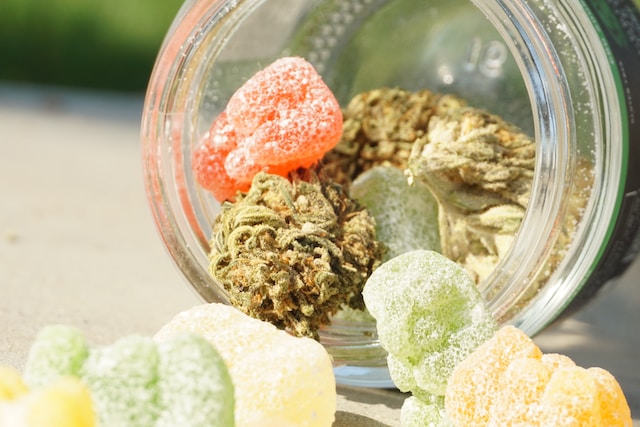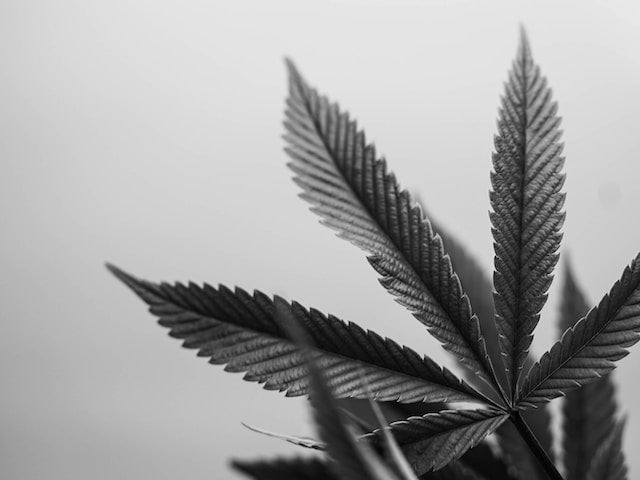Your cart is currently empty.

Ever stared at a pack of colorful gummy bears, imagining them infused with the magic of cannabis? That sweet, tangy flavor coupled with nature's chill pill - sounds like a dream. No longer just a dream, cannabis-infused gummy bears can now be created.
But here's the catch...
Cooking up these edible delights isn’t as simple as tossing some herbs into your grandma’s old candy recipe. It requires knowledge about laws and safety measures; understanding potential risks and nutrition information is crucial too. Are you prepared for this excursion?
The allure of making your own stash can pull strong but remember—each state has its own dance when it comes to cannabis laws. Recreational use might not fly everywhere.
Your curiosity piqued yet? Stay tuned... We're diving headfirst into all things 'cannabis-infused gummies'!
Understanding Cannabis Laws Across States
The disparity of cannabis regulations in the United States is as wide-ranging as its terrain. With recreational use permitted in some states, and only medical usage allowed in others like New York and Pennsylvania, it's clear that understanding these variations is key.
Variations in State Laws
State laws not only differ on who can legally consume cannabis but also what products dispensaries can offer to their customers. For instance, a dispensary might be able to sell THC-rich products for recreational users where it's legal but could need special authorization to provide CBD-based medications for certified patients.
As you traverse across state lines, so does your access to different forms of cannabis change dramatically. Imagine driving from Colorado, known for its weed-friendly stance with an array of choices at your disposal, then arriving into Nebraska where possession alone could land you fines or worse.
According to NCSL (National Conference of State Legislatures), cannabis isn't available recreationally everywhere. In fact, many states restrict its use strictly for medicinal purposes with strict rules around who qualifies as a patient.
This often raises the question: How do these variations impact consumers? Well simply put - location matters. The product selection available depends heavily on local regulations which are designed based on each state’s own interpretations and attitudes towards cannabis consumption.
The Responsibility of Cooking with Cannabis
Cooking with cannabis is not as simple as throwing a handful of green into your brownie mix. It's about understanding the potency, effects, and legality of what you're working with.
Ensuring Kitchen Safety
First things first - safety in the kitchen should always be priority number one. Working with raw ingredients requires careful handling to avoid injuries or mishaps. When cooking with cannabis, it’s crucial to take this caution even further because official food safety authorities might not have specific guidelines for these unique recipes.
You've got full responsibility here – no ifs or buts. So don't rush; give yourself enough time to cook without feeling rushed. This way, you can focus more on following instructions correctly and less on bandaging up those pesky knife cuts.
Selecting Quality Ingredients
Picking quality ingredients is just as important when making edibles as it is in any other culinary pursuit. But let me tell you something: shopping for weed isn’t like picking out fresh basil at your local farmer's market.
In states where recreational use is legal, dispensaries offer a wide range of products suitable for infusing foods—from oils and tinctures to actual flower buds—while others only allow sales to certified patients due to varying state laws regarding medical marijuana use.
Risks & Repercussions: What You Need To Know
Weed-infused gummies may sound fun (and they are.), but remember that every silver cloud has a potential storm. Adverse reactions to certain ingredients are a real possibility, especially if you're new to the game or have any underlying health conditions.
Remember that cooking with cannabis is not just about getting high—it's also about enjoying unique flavors and experiences in your culinary adventures. Therefore, it’s vital to review all listed ingredients before starting on your journey of making edible gummies.
Cooking with cannabis demands a focus on safety and quality. Handle all ingredients with care, noting that official food guidelines may not cover these unique recipes. Pick the best products from legal dispensaries, keeping in mind state laws differ. Remember, crafting weed-infused gummies isn't solely about the high - it's also a culinary journey. But stay mindful of possible side effects.
Reviewing Ingredients for Safe Consumption
Before beginning to craft your delicious gummies, be sure to double-check that all the ingredients are safe for consumption. After all, nobody wants an unpleasant surprise after enjoying their homemade treats.
Cannabis-infused recipes often call for some unique ingredients that may not be common in your everyday cooking. It's critical to carefully examine each component before incorporating them into your dish.
Potential Adverse Reactions
Some may have reactions to specific food items due to allergies or sensitivities. That's why reading through the list of ingredients is crucial when making edibles at home.
A quick Google search can give you plenty of information about an unfamiliar ingredient and its potential side effects. Remember though, what works fine for one person might cause adverse reactions in another due to individual differences in body chemistry and tolerance levels.
You also need to pay close attention if the recipe calls for specific cannabis strains or products like CBD oil or THC distillate. Some folks react differently to different cannabinoids so it’s best know your limits beforehand.
Minding The Dosage
An essential part of making sure everything goes smoothly is getting the dosage right with cannabis-infused edibles - more isn't always merrier here. Too much can lead from mild discomfort right up-to intense psychoactive experiences that could be quite uncomfortable.
Delta 8 gummies, for instance, can give a stronger high compared to their CBD counterparts. So it's wise to understand the effects of each cannabis product before incorporating them into your recipe.
Take note that it is your responsibility to review all listed ingredients in a recipe to ensure there are no potential adverse reactions. Don't be shy about doing research or asking experts when you're unsure about something - better safe than sorry.
The Right Ingredients For You
Finding the right ingredients for you might take some time and experimentation but don’t let this discourage you. Every individual has specific dietary requirements and inclinations that ought to be thought of when preparing food items at home.
You could consider starting with lower doses of cannabinoids.
When making cannabis-infused gummies, safety is key. Review all ingredients for potential adverse reactions and understand your own tolerance levels. Pay close attention to dosage - more isn't always better with edibles. Experiment to find the right balance of ingredients that suits you best.
Consulting Medical Professionals Before Use
Halt your enthusiasm for experimenting with cannabis-based dishes and take a moment to think about it. It's crucial that before trying any new substance or altering your diet in significant ways, you get some advice from a medical professional.
Why? Well, just like how everyone reacts differently to foods—some people can't handle spicy food while others seem born for hot wings—it's the same with cannabinoids. People have unique reactions and tolerances to substances such as CBD, Delta 8 THC, and Delta 9 THC.
This is where having an open conversation with your doctor becomes invaluable. They know your health history and current condition better than anyone else. Hence they can provide personalized guidance based on this knowledge.
The Need for Professional Advice
We often ask our friends about their experiences when we want to try something new but remember: no two bodies are exactly alike. What worked well for someone else might not be ideal—or safe—for you.
Your doctor isn’t there just for check-ups or when things go wrong—they’re also a great source of preventative care information.
Cannabis Reactions & Personal Health Concerns
When using any recipe involving cannabis products if they have concerns about individual reactions, users should consult with their healthcare provider first according to CDC guidelines.
Tailored Guidance Based on Your History
- If you've got allergies known or unknown - doctors will help uncover these issues.
- If expecting or nursing a child, certain substances could affect the infant's growth.
- If you've got any underlying health conditions - some cannabis compounds may interact with your medications or exacerbate symptoms.
Your physician can give personalized guidance based on a range of factors.
A Two-Way Conversation
The conversation about using cannabis-infused recipes should not just be a one-way street; it's equally important for users to ask their doctors questions they might have.
Before diving into cannabis-infused recipes, have a chat with your doctor. Everyone's body reacts differently to substances like CBD and THC, so get personalized advice based on your health history. Remember, trying new things is exciting but safety should always come first.
Understanding Risks and Nutrition Information
Dabbling in cannabis recipes? Great. But, let's chat about the risks first. By whipping up these dishes, you're signing an invisible contract that says you understand potential injuries may come knocking at your door.
Potential Risks of Using Cannabis Recipes
Using cannabis in cooking is like adding a wild card to your meal. It can turn things upside down if not handled correctly. It's crucial to remember everyone reacts differently to cannabis-infused foods. So, don't expect universal experiences or effects.
Imagine this: You make a batch of THC-loaded brownies and invite friends over for taste-testing (sounds fun right?). One buddy could be laughing his socks off while another might feel anxious or paranoid after consuming the same amount from the same pan. Studies show how diverse reactions can be with edible consumption due to individual differences in metabolism, tolerance levels and more.
Nutrition Information in Cannabis Recipes
The nutritional information we provide isn’t a prescription pad; it’s just some good old-fashioned advice intended for informational purposes only. No white coats involved here.
A bag of Doritos won't morph into health food even if it has CBD oil drizzled on top (we wish.). That said, adding cannabinoids into your diet doesn't give free rein to neglect nutrition altogether.
Cannabis cuisine tip: Think 'balanced'. Adding hemp seeds rich in protein onto salads or blending raw marijuana leaves full of vitamins into smoothies are great ways of making healthy choices while enjoying cannabinoids' benefits.
Think of your kitchen as a canvas and cannabis as an exciting color splash. But, remember, balance in diet—and life—is key. Our nutritional tips aren't set in stone; they're just here to guide you.
When cooking with cannabis, it's crucial to understand the potential risks. Everyone reacts differently to infused foods, leading to varied experiences and effects. So treat your kitchen as a balanced canvas - add nutritious choices like hemp seeds or raw marijuana leaves into meals while enjoying cannabinoids' benefits. But remember, our nutritional advice is just that—advice—not prescriptions.
FAQs in Relation to How to Make Edible Gummies
Can you make gummy edibles without lecithin?
Absolutely, but lecithin helps to bind the cannabinoids and fats for a more potent edible. It's not mandatory though.
How long do homemade edibles work?
Homemade edibles typically kick in within 30-90 minutes, with effects lasting around 4-12 hours depending on dose and tolerance.
How do you make gummy edibles work?
You need cannabis-infused oil or tincture. Mix it into your gummy mixture before setting them to solidify. Dose carefully.
Is there a difference between gummies and edibles?
Gummies are just one type of edible - they're candies infused with cannabis. Edible is the umbrella term for all food products containing cannabis.
Conclusion
That's it, folks! We've uncovered the layers of how to make edible gummies infused with cannabis.
The laws vary. Take heed of the various regulations that govern cannabis use in each state; safety should always be a priority. Keep that in mind!
Safety first! You need to ensure kitchen safety and be aware of potential adverse reactions from certain ingredients.
Seek advice before diving in headfirst. Consult medical professionals if you have health concerns about using these recipes.
Risks exist, so does nutrition information. Understand both thoroughly before venturing into this journey of creating your very own stash of delightful edibles.
Your dreams don’t just have to remain dreams anymore; armed with knowledge and caution, you're all set for a tasty adventure!



